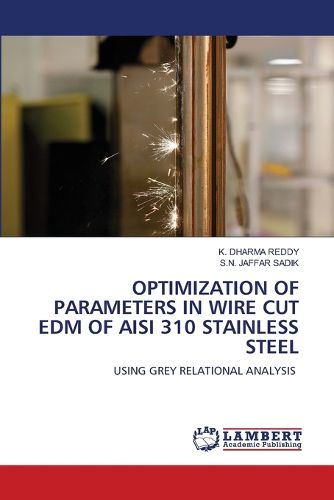Readings Newsletter
Become a Readings Member to make your shopping experience even easier.
Sign in or sign up for free!
You’re not far away from qualifying for FREE standard shipping within Australia
You’ve qualified for FREE standard shipping within Australia
The cart is loading…






In WEDM various techniques are applied to improve the material removal rate (MRR), surface roughness (SR) and kerf width (KF) with different electrode combination. Wire EDM is one of the non-traditional machining processes. This project summarizes the Taguchi optimization technique, in order to optimize the cutting parameters in Wire EDM for AISI 310 Stainless steel. In this present study AISI 310 Stainless steel is used as a work piece, brass wire of 0.25mm diameter used as a tool and distilled water is used as a dielectric fluid for experimentation Taguchi's L16, has been used. The input parameters selected for optimization are pulse on time (Ton), and pulse off time (Toff), wire tension (Wt) and wire feed. For each experiment surface roughness and Machining timing, MRR and kerf width is to be determined by using Taguchi optimization technique optimal value is obtained seperately. The data obtained from the presentwork is analyzed by using GREY REALTIONAL ANALYSIS, Additionally, the analysis of variance (ANOVA) is too useful to identify the main effect plots.
$9.00 standard shipping within Australia
FREE standard shipping within Australia for orders over $100.00
Express & International shipping calculated at checkout
In WEDM various techniques are applied to improve the material removal rate (MRR), surface roughness (SR) and kerf width (KF) with different electrode combination. Wire EDM is one of the non-traditional machining processes. This project summarizes the Taguchi optimization technique, in order to optimize the cutting parameters in Wire EDM for AISI 310 Stainless steel. In this present study AISI 310 Stainless steel is used as a work piece, brass wire of 0.25mm diameter used as a tool and distilled water is used as a dielectric fluid for experimentation Taguchi's L16, has been used. The input parameters selected for optimization are pulse on time (Ton), and pulse off time (Toff), wire tension (Wt) and wire feed. For each experiment surface roughness and Machining timing, MRR and kerf width is to be determined by using Taguchi optimization technique optimal value is obtained seperately. The data obtained from the presentwork is analyzed by using GREY REALTIONAL ANALYSIS, Additionally, the analysis of variance (ANOVA) is too useful to identify the main effect plots.